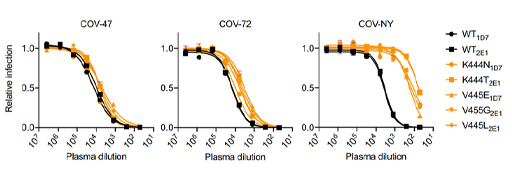3.2 Evasion of natural antibody-mediated immunity
The antibodies produced by a natural SARS-CoV2 infection or by a spike protein vaccine, are polyclonal; they are produced be many different clones of B cells and usually they will recognise a variety of different epitopes on the spike protein. It is therefore unlikely that a new variant of the spike protein could be so different from an earlier variant that it could completely evade the antibodies produced against an earlier variant or vaccine formulation. However each person produces a different spectrum of antibodies against epitopes on the spike protein, and virus variants will be better able to evade immunity in some people than others (Figure 7)

The three subjects had been naturally infected with an original (wild type (WT)) strain of the virus. In these plots a high dilution of plasma relates to a low concentration of plasma antibodies. The assays were carried out using two wild-type viruses (WT1D7 and WT2E1) which had been mutated in two positions (444 and 445) in the spike protein. The plasmas from COV-47 and COV-72 were almost as effective in neutralising mutated virus (orange lines) as the original virus (black lines). However the antibodies in COV-NY plasma were much less effective at neutralising the mutated variants- it requires 100x more antibody to produce a similar level of neutralisation. This result shows that a substantial amount of antibody in COV-NY plasma is binding to an epitope on the spike protein that involves amino acids 444 and 445.
This variation between people in antibody production may explain why some people have been more susceptible to reinfection than others. Variation between individuals also applies to susceptibility to infection following vaccination.
